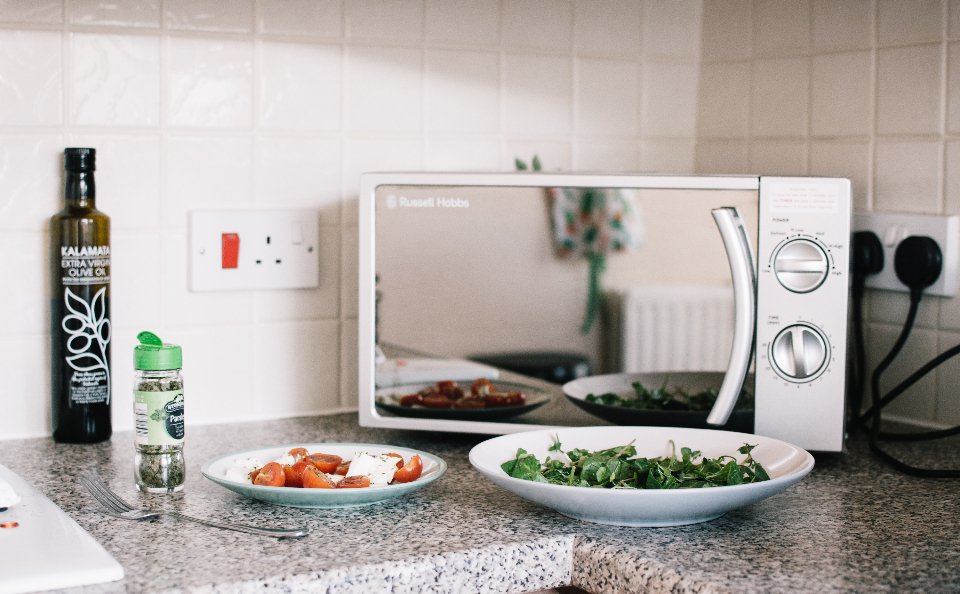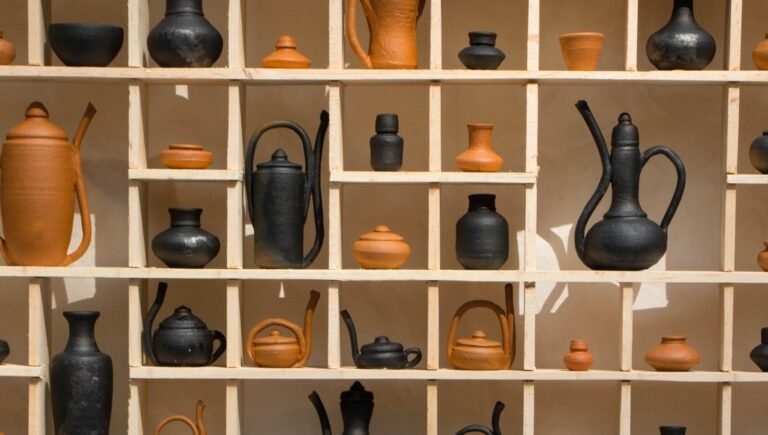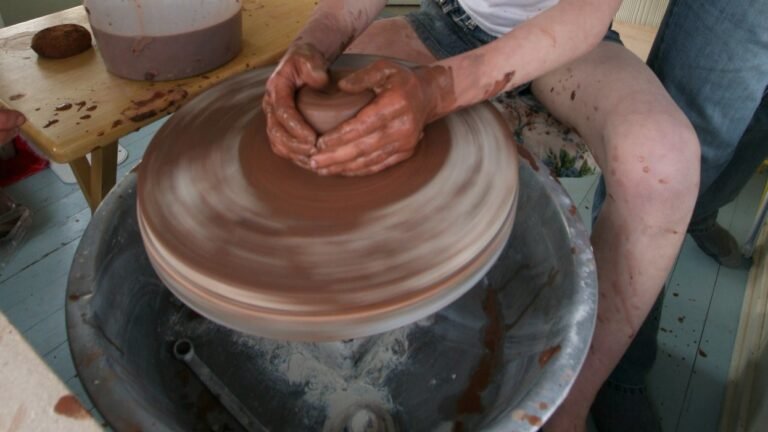Can You Microwave Handmade Ceramics? (Explained)
It’s stressful to put handmade ceramics in the microwave for the first time. Especially if they’re unique items that you spent so much energy on, you don’t want them to break or explode, or for chemicals to get into your food.
How do you avoid this from happening? Which handmade ceramics are suitable for microwaving and which aren’t?
Most handmade ceramics are completely safe to put in the microwave. Stoneware and especially porcelain are safe for microwaving. If your ceramics are made from earthenware, terracotta, or other materials that absorb a lot of water, then they are unsuitable for the microwave.
Whether materials are suited for the microwave, depends on their absorption rate. In addition, it’s important that they are glazed for daily use, and that they don’t have any metal decorations.
I will show you how to spot what materials were used in your favorite ceramics, and which materials you should avoid putting in the microwave.
Can You Put Ceramics in the Microwave?
I know the fear that comes with putting unique ceramics in the microwave. If it breaks, you will never get the exact same piece again.
Also, it’s such a waste of energy. But then again, it would be a waste too if you avoid the microwave at all costs, while it’s perfectly safe to use in most cases.
Most ceramics are fine to put in the microwave. Whether you’re heating up leftovers in a nicely decorated bowl or making a muffin in a cup, it’s fine.
[amazon box=”B09WQM3SK7″]
There are certain materials that you should not put in the microwave, though.
It all depends on the absorption rate. Some materials have a high absorption rate, which means that they can absorb more water than other materials.
The absorption happens for instance when they go in the dishwasher or when you rinse them by hand.
When they go in the microwave, the water that is in the microscopic cavities of the earthenware will generate heat much faster than the food or drinks that you’re trying to heat up. This heat has nowhere to go, as the microscopic cavities can’t let off steam easily.
The result is that your earthenware can break, or even explode. Because it captures heat, another risk is that you burn your hand.
There is a simple way to avoid this from happening. Pay attention to the materials that you put in the microwave.
Earthenware and terracotta are risky because they can absorb 10 – 15% of their weight in water. This is why you should never put terracotta in the microwave.
Safe materials are stoneware and porcelain. Especially porcelain is safe to use, as it absorbs only 0 – 1 % of its weight in water.
Stoneware is fine too, as it absorbs about 2 – 5 % of water. This can differ, though. Some clay soaks up more water than other clay.
How Do You Tell the Difference between Earthenware and Stoneware?
When you buy ceramics at a store, it’s always a good idea to ask about the absorption rate and write it down somewhere, in case you need it later.
This also goes for pottery that you make in a pottery class, always ask about the materials used and whether you can put them into a microwave.
When it comes to ceramics that you created in the past or handmade ceramics that you find in secondhand stores, it can be tricky to determine the absorption rate.
Both earthenware and stoneware come in all sorts of colors and shapes. Usually, earthenware has a smoother texture, but not in all cases, as it depends on how the materials worked and how much grog was added.
Porcelain is a little easier to distinguish because it looks more delicate and polished. It’s more expensive and hence also rarer.
How Do You Determine the Absorption Rate of Ceramics?
If you want to determine the absorption rate of certain ceramics, there is a DIY home method to use.
First, make sure the item is completely dry. Don’t use it for a week and put it in a warm (but not moist!) spot, for instance in the sun. Then measure how much it weighs when it’s completely dry, preferably to the gram.
Next, submerge the item in water for 24 hours. The item should be fully submerged, so it can soak up all the water it can. If you weigh the item again, you can tell how much water it absorbs.
Ideally, the absorption rate should be below 1%. You can calculate the rate by dividing the weight difference by the weight when the item was dry and multiplying this number by 100.
As an example, if a bowl weighs 620 grams when dry, and 625 when wet, then the weight difference is 5 grams. (5 / 620) x 100 = 0.81 %. So in this case, the absorption rate is only 0.81 %, and the item is safe to microwave.
Keep in mind that this method is not guaranteed to give you an accurate result, as there can be all kinds of elements that influence humidity and thus how much water your ceramics soak up and release.
However, when it’s impossible to retrieve the exact absorption rate from the source of the materials, this DIY method comes in handy.
Is It Safe to Microwave Ceramic Mugs?
For mugs, there are more factors that contribute to whether they’re suitable for microwaving than other pieces. Things like bowls and plates often don’t have the same decorations and details.
I once got a mug from my best friend that had a picture of the two of us printed on it. It was a really sweet idea, but after a couple of weeks, the picture started showing cracks. I decided not to put this mug in the microwave, to prevent it from disintegrating any further.
As a general rule of thumb, mugs are safe to use in the microwave, even if they’re personalized or have a print on them but keep them out of the microwave when the printing shows cracks.
Another thing to be aware of is that mugs should not have metallic trims. If your mug has golden details, don’t put it in the microwave, as metal is sometimes used as a base for golden ridges.
When you do put metal in a microwave, it can overheat. If arcing occurs, then the chemicals can get into your dish, and it could damage the microwave. Something to keep in mind with mugs that have trims in a metallic or golden color.
What Makes Ceramics Microwave Safe?
There are three things to check before putting ceramics into the microwave.
- First, check the material. If it’s porcelain, then it’s safe, and if it’s stoneware, it’s usually safe too. Earthenware is unsuitable.
- Secondly, check whether ceramics have a glaze. All handmade pottery that is used in the kitchen should have a glaze, not just for microwaving, but also for safeguarding that no chemicals are transferred onto food.
- Lastly, any ceramics with metallic or golden trims should not go in the microwave, to avoid arcing.
What makes ceramics safe to microwave, are the materials used, the glaze, and the absence of any metal details.

If your ceramics fit all the above criteria, then you can turn on the microwave. What if you’re still in doubt? For instance, if you have earthenware with an absorption rate of 5%, how do you know what to do?
When in doubt, the key is to conduct a little test to see how the ceramics will respond to the microwave. If you have a mug or a bowl, fill it halfway with water, and put it in the microwave for around a minute. If it smells weird, then stop the microwave.
If microwaving for a minute without incidents works, then you can try it out for a longer period of time.
But if the handle of your mug or other elements of the ceramics gets extraordinarily hot, like even hotter than the water contents, then your ceramics aren’t suitable for microwaving.
In that case, the ceramics are incapable of transmitting the heat sufficiently, and they could be dangerous to microwaves. You could burn your hands, or they could crack.
Will Ceramics Crack in the Microwave?
Most ceramics will not crack in the microwave. The chance of getting cracks is higher in earthenware than in stoneware and porcelain.
To prevent your favorite pottery from getting cracks, always be aware of the criteria outlined above. Make sure that the absorption rate of your pottery is low, that it is glazed, and that it doesn’t contain metal details.
If your ceramics are suitable for microwaves, then you’re good to go. First, give it a try for a minute or so, and after that, you can put the items in the microwave for a longer timeframe. Don’t be too stressed, as most ceramics are completely safe for microwaving!







